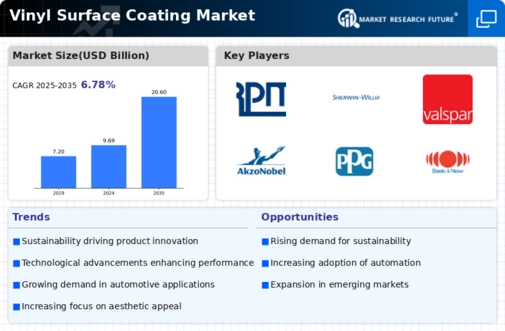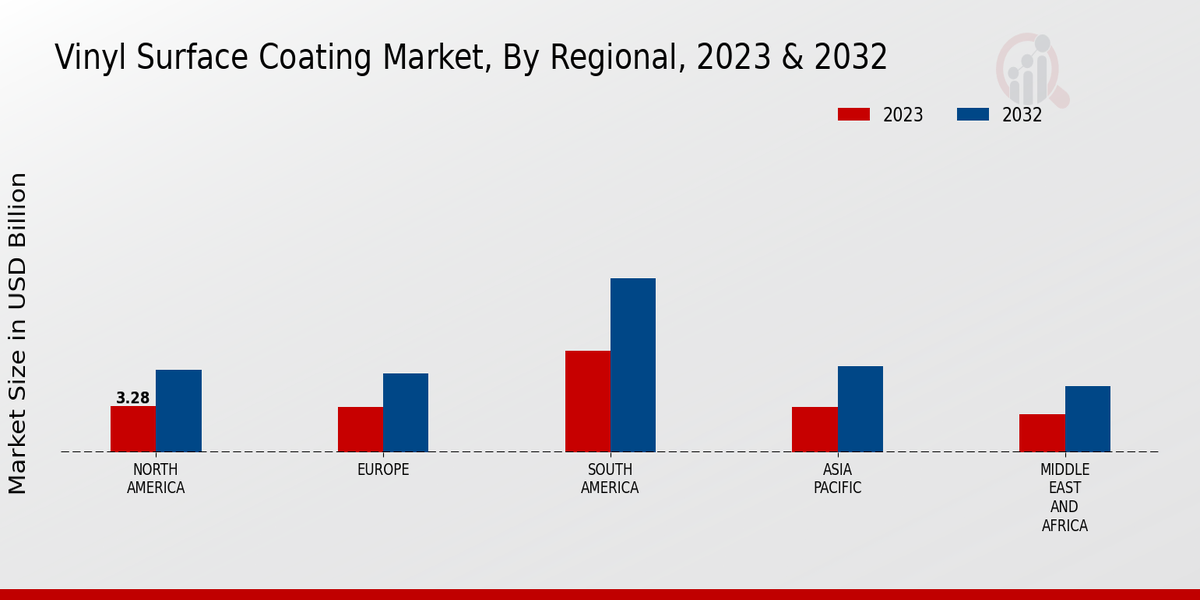Market Growth Projections
The Global Vinyl Surface Coating Market Industry is projected to experience substantial growth, with estimates indicating a market size of 9.69 USD Billion in 2024 and a remarkable increase to 20.6 USD Billion by 2035. This growth trajectory suggests a compound annual growth rate of 7.09% from 2025 to 2035, reflecting the increasing adoption of vinyl coatings across various applications. The market dynamics are influenced by factors such as technological advancements, environmental considerations, and the expansion of end-use industries. These projections highlight the potential for vinyl coatings to play a crucial role in the future of surface protection.
Expansion of End-Use Industries
The expansion of end-use industries such as automotive, construction, and consumer goods is a key driver for the Global Vinyl Surface Coating Market Industry. As these sectors grow, the demand for high-performance coatings that offer aesthetic appeal and protection increases. For instance, the automotive industry is increasingly utilizing vinyl coatings for vehicle exteriors, enhancing both durability and visual appeal. This trend is expected to contribute to a compound annual growth rate of 7.09% from 2025 to 2035, indicating robust market potential. The diversification of applications across various industries further supports the growth trajectory of vinyl coatings.
Growing Environmental Awareness
The Global Vinyl Surface Coating Market Industry is significantly influenced by growing environmental awareness among consumers and manufacturers. There is an increasing preference for eco-friendly coatings that minimize harmful emissions and comply with stringent regulations. Vinyl coatings, particularly those formulated with low volatile organic compounds (VOCs), are gaining traction as sustainable alternatives. This shift towards environmentally responsible products is expected to drive market growth, as companies seek to enhance their sustainability profiles. The industry's commitment to reducing its environmental footprint aligns with broader global trends towards sustainability, potentially boosting market demand.
Rising Demand for Durable Coatings
The Global Vinyl Surface Coating Market Industry experiences a surge in demand for durable coatings, driven by the need for long-lasting protection in various applications. Industries such as automotive, construction, and consumer goods increasingly favor vinyl coatings due to their resistance to wear, chemicals, and environmental factors. This trend is reflected in the projected market growth, with the industry expected to reach 9.69 USD Billion in 2024. The durability of vinyl coatings not only enhances product lifespan but also reduces maintenance costs, making them an attractive option for manufacturers and consumers alike.
Regulatory Support for Coating Innovations
Regulatory support for innovative coating solutions is a significant driver for the Global Vinyl Surface Coating Market Industry. Governments worldwide are implementing policies that encourage the development and use of advanced coatings, particularly those that meet environmental standards. This regulatory framework fosters innovation and investment in vinyl coatings, promoting their adoption across various sectors. As manufacturers align their products with these regulations, the market is likely to benefit from increased demand. The proactive stance of regulatory bodies not only enhances product safety but also encourages sustainable practices within the industry.
Technological Advancements in Coating Applications
Technological advancements play a pivotal role in shaping the Global Vinyl Surface Coating Market Industry. Innovations in application techniques, such as spray and electrostatic methods, enhance the efficiency and effectiveness of vinyl coatings. These advancements allow for better adhesion, uniform coverage, and reduced waste, which are critical for meeting the increasing demands of various sectors. As manufacturers adopt these technologies, the market is likely to witness accelerated growth, contributing to an anticipated market size of 20.6 USD Billion by 2035. The integration of technology not only improves product performance but also aligns with sustainability goals.










